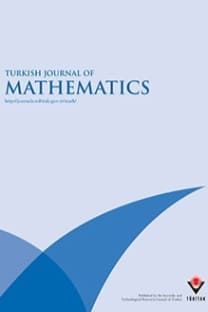Note on the divisoriality of domains of the form k[[Xp,Xq]]k[[Xp,Xq]], k[Xp,Xq]k[Xp,Xq], k[[Xp,Xq,Xr]]k[[Xp,Xq,Xr]], and k[Xp,Xq,Xr]
Note on the divisoriality of domains of the form k[[Xp,Xq]]k[[Xp,Xq]], k[Xp,Xq]k[Xp,Xq], k[[Xp,Xq,Xr]]k[[Xp,Xq,Xr]], and k[Xp,Xq,Xr]
___
- [1] Anderson DD, Anderson DF, Costa DL, Dobbs DE, Mott JL, Zafrullah M. Some characterizations of v-domains and related properties. Colloq Math 1989; 58: 19.
- [2] Anderson DF. Comparability of ideals and valuation overrings. Houston J Math 1979; 5: 451463.
- [3] Anderson DF. Seminormal graded rings II. J Pure Appl Algebra 1982; 23: 221226.
- [4] Anderson DF. When the dual of an ideal is a ring. Houston J Math 1983; 9: 325332.
- [5] Anderson DF, Chapman S, Inmanand F, Smith W. Factorization in K[X2 , X3 ]. Arch Math 1993; 61: 521528.
- [6] Anderson DF, Dobbs DE. Pairs of rings with the same prime ideals. Canad J Math 1980; 32: 362384.
- [7] Anderson DF, Dobbs DE, Huckaba JA. On seminormal overrings. Comm Algebra 1982; 10: 14211448.
- [8] Anderson DF, Jenkens S. Factorization in K[X n , Xn+1, . . . , X2n−1 ]. Comm Algebra 1995; 23: 25612576.
- [9] Anderson DF, Winner J. Factorization in K[[S]]. Lect Notes Pure Appl 1997; 189: 243255.
- [10] Bass H. On the ubiquity of Gorenstein rings. Math Z 1963; 82: 828.
- [11] Bazzoni S. Divisorial domains. Forum Math 2000; 12: 397419.
- [12] Bazzoni S, Salce L. Warfield domains. J Algebra 1996; 185: 836868.
- [13] Dobbs DE, Fedder R. Conducive integral domains. J Algebra 1984; 86: 494510.
- [14] Fontana M. Topologically defined classes of commutative rings. Ann Mat Pura Appl 1980; 123: 331355.
- [15] Fontana M, Huckaba JA, Papick IJ. Domains satisfying the trace property. J Algebra 1987; 107: 169182.
- [16] Fontana M, Huckaba JA, Papick IJ, Roitman M. Pr¨ufer domains and endomorphism rings of their ideals. J Algebra 1993; 157: 489516.
- [17] Gilmer R. Some finiteness conditions on the set of overrings of an integral domain. P Am Math Soc 2003; 131: 23372346.
- [18] Gilmer R. Multiplicative Ideal Theory. New York, NY, USA: Marcel Dekker, 1972.
- [19] Heinzer W. Integral domains in which each non-zero ideal is divisorial. Matematika 1968; 15: 164170.
- [20] Heinzer W, Olberding B. Unique irredundant intersections of completely irreducible ideals. J Algebra 2005; 287: 432448.
- [21] Heinzer W, Papick IJ. The radical trace property. J Algbra 1988; 112: 110121.
- [22] Houston EG, Mimouni A, Park MH. Noetherian domains which admit only finitely many star operations. J Algebra 2012; 366: 7893.
- [23] Kaplansky I. Commutative Rings, Revised Edition. Chicago, IL, USA: Chicago University Press, 1972.
- [24] Kunz E. The value-semigroup of a one-dimensional Gorenstein ring. P Am Math Soc 1970: 25: 748751.
- [25] Lucas TG. The radical trace property and primary ideals. J Algebra 1996; 164: 10931112.
- [26] Lucas TG, Mimouni A. Trace properties and integral domains, II. Comm Algebra 2012; 40: 497513.
- [27] Matlis E. Reflexive domains. J Algebra 1968; 8: 133.
- [28] Swan RG. On seminormality. J Algebra 1980; 67: 210229.
- [29] Zafrullah M. What v-coprimality can do for you. In: Brewer JW, Glaz S, Heinzer W, Olberding B, editors. Multiplicative Ideal Theory in Commutative Algebra. New York, NY, USA: Springer, 2006, pp. 387404.
- ISSN: 1300-0098
- Yayın Aralığı: 6
- Yayıncı: TÜBİTAK
Rongmin ZHU, Zhongkui LIU, Zhanping WANG
Kübra GÜL, Nurullah ANKARALIOGLU
Eylem Güzel KARPUZ, Fırat ATEŞ, Ahmet Sinan ÇEVİK, İsmail Naci CANGÜL
